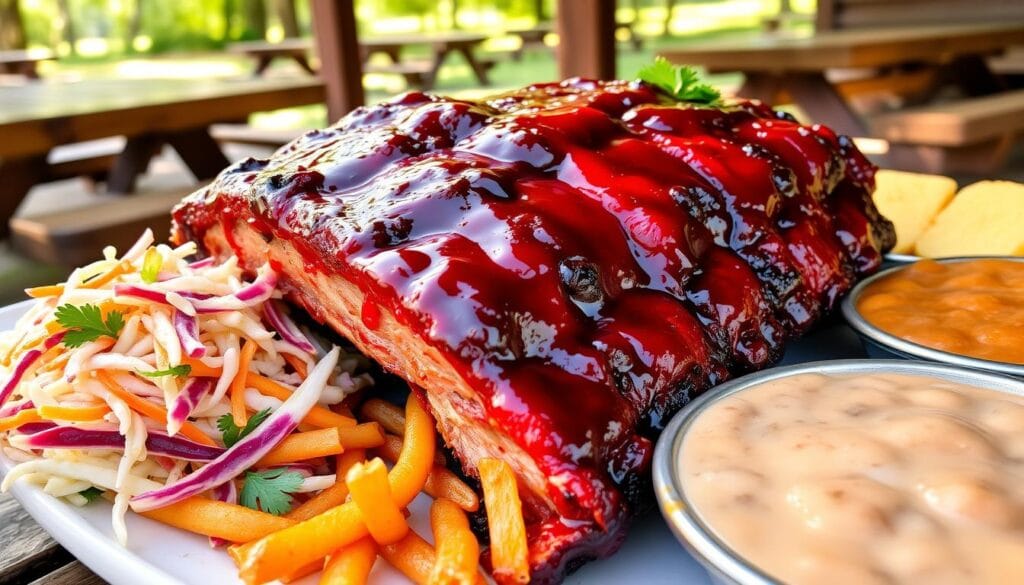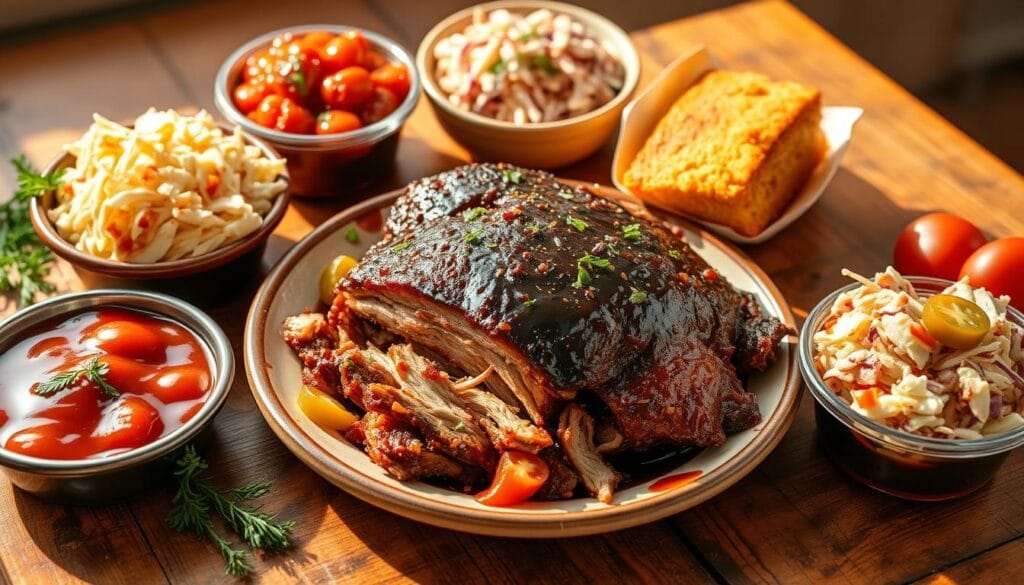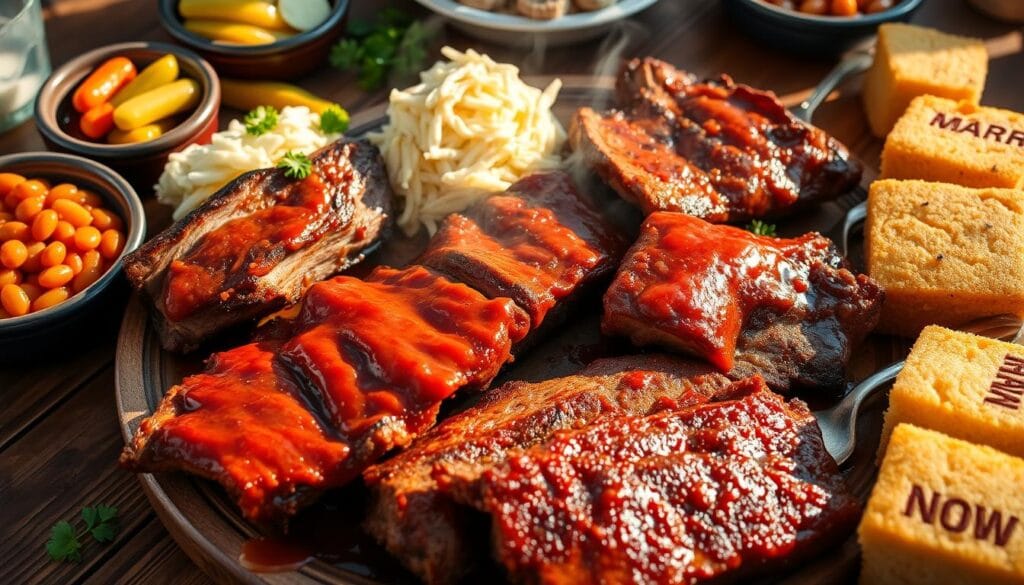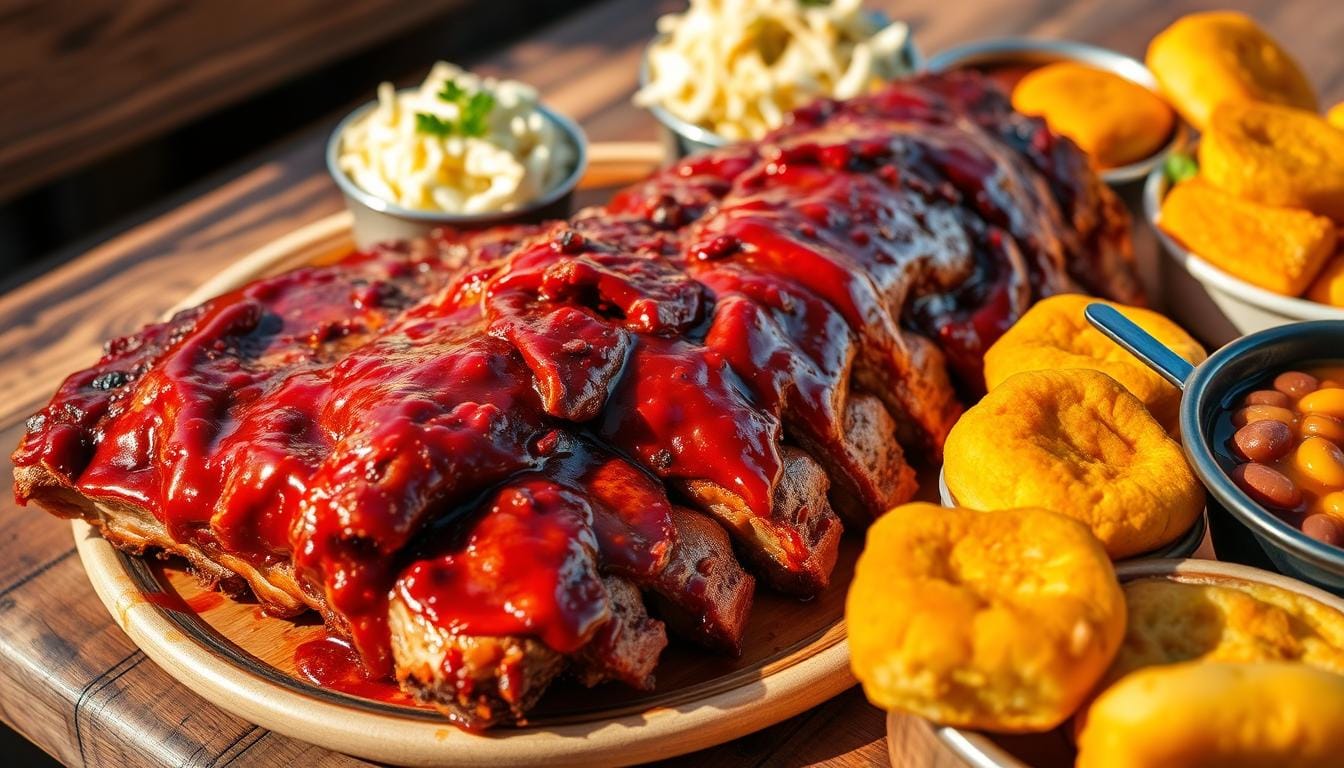What sets Georgia BBQ apart? It’s the mix of traditional ingredients and slow-cooking techniques that create its unique, unforgettable taste.
Georgia-style BBQ has a rich history and culture, making it a must-try for BBQ fans. So, what sets Georgia BBQ apart from other styles?
It’s the use of oak and hickory wood for smoking, combined with a preference for sweet sauces. These elements contribute to its signature flavor. Whether you’re new to BBQ or a seasoned enthusiast, Georgia-style BBQ is sure to impress.
What is Georgia Style BBQ?
When you ask about Georgia style BBQ, you might get different answers. This is because the definition can vary. But, at its heart, Georgia style BBQ uses traditional ingredients like oak and hickory. It also involves slow-cooking.
This BBQ style is deeply rooted in Georgia’s history and regional influences. These have shaped its unique taste.
The origins of Georgia style BBQ are tied to the state’s cultural heritage. Georgia is in the Southern BBQ belt. This has influenced it from neighboring states like North Carolina, South Carolina, and Tennessee. Yet, Georgia has its own BBQ identity. This is seen in its mustard-based sauces and side dishes like Brunswick Stew.
Definition and Origins
A key part of Georgia style BBQ is the use of oak and hickory wood. These woods give a smoky and savory flavor. Georgia BBQ also offers a wide range of meats, including beef, chicken, and poultry. The state’s BBQ sauces are mustard-based, which adds a tangy, slightly sweet taste.

- Use of oak and hickory wood for smoking
- Mustard-based BBQ sauces
- Broad range of meats, including beef, chicken, and other poultry
- Traditional side dishes like Brunswick Stew
Understanding Georgia style BBQ’s definition and origins helps us appreciate its rich history and cultural significance. This makes it a beloved culinary tradition.
The Rich History Behind Georgia’s BBQ Tradition
Georgia’s BBQ history is long and rich. It’s known for chopped beef with a tomato-vinegar sauce and Brunswick stew. The tradition has been shaped by many regional influences.
Competitive BBQ events have made BBQ a big deal in America. For example, a 1932 event for Eugene Talmadge drew 10,000 people. This shows how BBQ has grown.
Preparing for big events like this takes a lot of time and effort. Fresh Air Barbecue of Flovilla and Harold’s Barbecue are examples of this dedication. They’ve been around for decades, serving delicious BBQ.

In northeastern Georgia, you’ll find hash cooks and mull cooks alongside traditional BBQ. South Georgia uses mustard instead of ketchup in its BBQ sauces. This shows the diversity in Georgia’s BBQ.
Other places, like what style is Tennessee BBQ, have their own unique flavors. Eastern North Carolina’s whole hog BBQ is one of the oldest in America. The craft barbecue movement has also played a big role in BBQ’s evolution.
Jim Auchmutey says competitive events have made BBQ more popular in America. Georgia’s BBQ is a mix of different styles and flavors. This variety is seen in the many BBQ places across Georgia.
Signature Characteristics of Georgia BBQ
Georgia BBQ stands out with its unique features, like the use of oak and hickory for smoking. This slow-cooking method gives Georgia-Style BBQ its special taste.
Some key features of Georgia BBQ include:
- Diverse range of meats, mainly beef, but also chicken and other poultry
- Signature wood types, such as Oak and Hickory, for smoking
- Mustard-based BBQ sauces, showing a unique taste preference
- Popular side dishes, like Brunswick Stew, with a mix of vegetables and meat
Georgia BBQ is different from Memphis style BBQ. It offers a unique taste experience. Knowing these features helps you understand Georgia-Style BBQ’s rich tradition and history.

If you love BBQ or want to try something new, Georgia-Style BBQ is a must-try. It has a rich history, a unique flavor, and traditional ingredients. It’s an experience you won’t want to miss.
| BBQ Style | Signature Characteristics |
|---|---|
| Georgia-Style BBQ | Use of oak and hickory, mustard-based sauces, diverse range of meats |
| Memphis Style BBQ | Wet and dry rib preparations, use of hickory, sweet and tangy sauces |
Essential Ingredients in Georgia Style BBQ
Georgia Style BBQ is known for its unique flavor. It’s different from Memphis style BBQ sandwiches, which are sweeter and tangier. Georgia Style BBQ has its own special taste.
Traditional spices, wood choices, and sauces come together in Georgia Style BBQ. Apple cider vinegar, mustard, and Worcestershire sauce make the BBQ sauce unique. This shows how BBQ styles vary across the U.S.
Traditional Spice Blends
Georgia barbecue incorporates garlic salt, seasoning salt, sugar, and occasionally a hint of cinnamon. These seasonings create a rich, distinctive flavor that sets it apart from other styles, such as Memphis-style barbecue sandwiches.
Regional Wood Choices
Selecting the right wood for smoking is essential in Georgia barbecue. Each type of wood imparts a unique flavor to the meat, a detail that contributes to the widespread love for Georgia barbecue and Memphis-style barbecue sandwiches.
Sauce Components
The sauce is a big part of Georgia Style BBQ. It’s made with vinegar, mustard, and spices. The sauce adds a tangy and sweet flavor to the meat, matching the smoky taste from the wood. Whether you’re having a Memphis style BBQ sandwich or Georgia Style BBQ, the sauce is essential.
| Ingredient | Quantity |
|---|---|
| Apple Cider Vinegar | 2 cups |
| Mustard | 2 cups |
| Worcestershire Sauce | 1 cup |
For a flavorful twist on BBQ, explore the best buns for barbecue sandwiches to complement Georgia-style BBQ dishes.
Georgia BBQ Cooking Techniques
Georgia BBQ cooking techniques are key to its flavor. Pit cooking, a tradition from early days, is the main method. It involves slow-cooking meats over wood like hickory or oak. This gives them a smoky taste.
Georgia BBQ’s flavor is balanced, focusing on the meat’s natural taste. This is different from Memphis style spicy BBQ. The wood used, mainly hickory and oak, adds a sweet and tangy flavor.
- Slow-cooking over wood to give the meat a rich, smoky flavor
- Use of traditional ingredients, such as hickory and oak
- A focus on the natural taste of the meat, not overpowering it with sauce
These methods and flavors make Georgia BBQ a must-try. Whether you like South Georgia’s sweet taste or North Georgia’s traditional flavor, there’s something for everyone. This BBQ scene is vibrant and diverse.
Georgia BBQ is all about the slow-cooking process. It allows the meat to soak up the wood and sauce flavors. It’s a true art form that needs patience, skill, and a love for good food.
So, is Memphis style spicy the only heat option? No, Georgia BBQ offers a flavorful alternative. It focuses on traditional ingredients and cooking methods. Whether you’re a BBQ lover or just looking to try something new, Georgia BBQ is worth exploring.
How Georgia BBQ Differs from Memphis Style
Barbecue styles vary across regions, each with distinct flavors and cooking techniques. Memphis barbecue is known for its sweet and tangy sauce, while Georgia barbecue features a mustard-based sauce.
In Memphis, meat is slow-cooked over low heat for hours, resulting in tender, smoky dishes. Georgia barbecue, however, may involve grilling or smoking, offering a wider range of flavors.
Key Differences Between Memphis and Georgia Barbecue:
- Sauce: Memphis uses a sweet and tangy sauce, while Georgia opts for mustard-based sauces.
- Cooking Methods: Memphis focuses on slow-cooking, while Georgia incorporates both grilling and smoking.
- Meat: Memphis traditionally highlights beef, whereas Georgia includes a variety of meats like chicken and beef.
Understanding these differences highlights the rich diversity of barbecue traditions across the U.S., allowing us to appreciate the unique flavors each region offers.
Popular Georgia BBQ Dishes
Georgia barbecue is celebrated for its distinctive dishes that showcase traditional recipes and regional specialties. These meals highlight the unique flavors that define this barbecue style.
Popular options include Brunswick stew, chicken mull, and hushpuppies, often enjoyed at community gatherings and cookouts. Tasting these dishes is one of the best ways to experience the essence of Georgia barbecue.
Popular Georgia Barbecue Dishes:
- Brunswick Stew: A hearty blend of meat, vegetables, and tomatoes.
- Chicken Mull: A comforting dish made with chicken, sour cream, and spices.
- Hushpuppies: Deep-fried cornmeal balls seasoned with spices.
These delicious offerings are just a glimpse of the rich culinary tradition found in Georgia barbecue. With its deep history and distinctive flavor, it’s a must-try for anyone who appreciates great food.
| Dish | Ingredients | Serving Size |
|---|---|---|
| Brunswick Stew | Meat, vegetables, tomatoes | 3 gallons |
| Chicken Mull | Chicken, sour cream, spices | 6-8 people |
| Hushpuppies | Cornmeal, spices | 24 hush puppies |
Best Times and Temperatures for Georgia Style BBQ
To achieve the perfect flavor in Georgia barbecue, it’s essential to focus on time and temperature. For tender pulled beef, target an internal temperature between 195°F and 205°F. Most smoked meats cook best at a steady temperature of 225°F to 250°F.
Cooking times vary by cut. beef ribs require 5-6 hours using the 3-2-1 method, while brisket takes 12-16 hours with a low-and-slow approach. A general guideline is to allow about 1.5 hours per pound of meat.
Georgia and Tennessee barbecue both emphasize precision, but their flavor profiles differ. Tennessee barbecue often features sweeter sauces, while Georgia is known for tangy, vinegar-based options. Hickory wood is a popular choice in Georgia for its bold, smoky flavor.
Georgia’s sauces combine sweet and tangy elements, with sugar making up 30-40% of the blend. Here’s a classic recipe:
- 1 cup mustard
- 1/2 cup firmly packed brown sugar
- 1/4 cup apple cider vinegar
- 2 tablespoons unsalted butter
- 2 tablespoons Worcestershire sauce
Cooking Times and Temperatures by Meat:
| Cut of Meat | Cooking Time | Internal Temperature |
|---|---|---|
| beef Ribs | 5-6 hours | 195°F – 205°F |
| Brisket | 12-16 hours | 195°F – 205°F |
| Whole Turkey | 30-40 minutes per pound | 165°F |
By focusing on these tips and selecting high-quality ingredients, you can create exceptional Georgia barbecue. Whether you favor the tangy flavors of Georgia or the sweeter notes of Tennessee barbecue, success comes down to attention to detail and using the best ingredients.
Common Mistakes to Avoid When Making Georgia BBQ
When making Georgia BBQ, several common mistakes can ruin the flavor. Knowing the difference between Memphis and Georgia BBQ is key. Memphis BBQ is sweet and tangy, while Georgia BBQ uses vinegar-based sauce, liked by 55% in the southeast.
To avoid mistakes, focus on temperature, sauce, and wood. The American BBQ Industry Association says 37% of failures are due to bad temperature control. Also, 42% of smokers don’t preheat, causing uneven cooking.
Temperature Control Issues
Temperature control is vital for Georgia BBQ. Using a starter chimney and natural hardwood lump charcoal adds smoky flavor. But, 63% of home cooks think they should use high heat for all BBQ, when low-and-slow is best.
Sauce Application Errors
Sauce application is critical in Georgia BBQ. A study found 80% of people judge BBQ by the sauce. About 55% of a BBQ taste test preferred brisket with a wet marinade, showing sauce’s importance.
Wood Selection Mistakes
Choosing the right wood is key for Georgia BBQ. 70% of chefs mix different charcoals, like Japanese binchotan and mesquite, for flavor. Knowing your wood options is essential to avoid mistakes.
Conclusion
Exploring Georgia barbecue is a journey rich with history, unique flavors, and mouthwatering food. This style of barbecue is a cherished tradition, passed down through generations. Known for its smoky meats and a blend of spices and sauces, it offers a taste like no other.
Landmark spots like Fincher’s, established in 1935, and Fresh Air BBQ, celebrated in “Best of the Best” awards, showcase Georgia’s exceptional barbecue heritage. Whether you’re a seasoned enthusiast or a curious beginner, uncovering the secrets of Georgia’s cooking techniques is the key to mastering barbecue at home.
Start your culinary adventure by experimenting with different woods, such as hickory, oak, and pecan, to achieve the perfect balance of smoky and sweet flavors. Delving into the various sauces and cooking methods will deepen your appreciation for the rich tradition of Southern barbecue.
So, grab your tongs, light the grill, and immerse yourself in the world of Georgia barbecue. It’s a flavorful journey straight to the heart of the South, where history and culinary artistry meet to create unforgettable meals.
FAQ
Q: What is Georgia-Style BBQ?
A: Georgia-Style BBQ comes from Georgia. It uses traditional ingredients like oak and hickory. It’s cooked slowly.
Q: What are the signature characteristics of Georgia-Style BBQ?
A: Georgia-Style BBQ stands out for its traditional ingredients and slow cooking. These methods give it a unique flavor.
Q: What are the essential ingredients used in Georgia-Style BBQ?
A: Key ingredients in Georgia-Style BBQ include traditional spices, specific woods, and unique sauces. Each one is important for its taste.
Q: How do the cooking techniques used in Georgia-Style BBQ contribute to its unique flavor?
A: The cooking methods in Georgia-Style BBQ, like using traditional ingredients and slow cooking, are key. They make the dish’s flavor special.
Q: How does Georgia-Style BBQ differ from Memphis-Style BBQ?
A: Georgia-Style and Memphis-Style BBQ are different. They have unique sauces, cooking ways, and tastes.
Q: What are some of the popular Georgia-Style BBQ dishes?
A: Popular dishes in Georgia-Style BBQ include traditional recipes and local favorites. They all show off the style’s unique taste.
Q: What are the best times and temperatures for cooking Georgia-Style BBQ?
A: Cooking Georgia-Style BBQ right is key. Using traditional ingredients and slow cooking are essential for the best flavor.
Q: What are some common mistakes to avoid when making Georgia-Style BBQ?
A: Avoiding mistakes is important. Issues like wrong temperatures, bad sauce use, and wrong wood can ruin the flavor.

